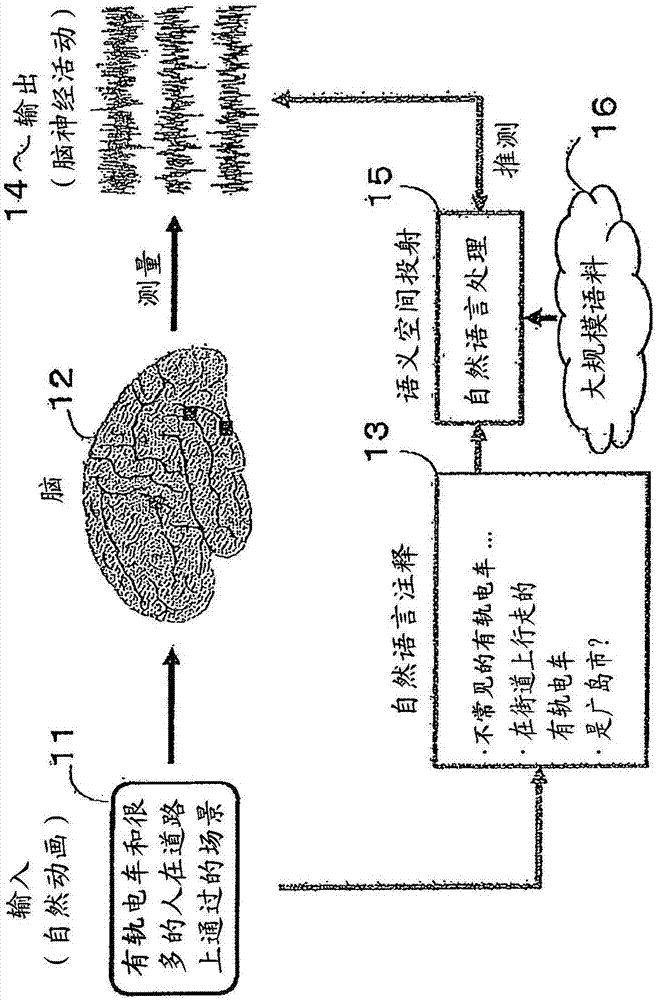Method for estimating perceptual semantic content by analysis of brain activity
A brain activity, activity detection technology, applied in semantic analysis, neural learning methods, sensors, etc., can solve problems such as coding model difficulties
- Summary
- Abstract
- Description
- Claims
- Application Information
AI Technical Summary
Problems solved by technology
Method used
Image
Examples
Embodiment 1
[0037] Figure 4 A configuration example of a device for applying the present invention is shown. In the display device 1, training stimuli (images, animations, etc.) are presented to the subject 2, and the brain activity of the subject 2 is detected by the brain activity detector 3 capable of detecting, for example, EEG (brain waves) and fMRI signals. Signal. As brain activity signals, the activation patterns of brain nerve cells, and signals of activity changes in single or multiple specific regions are detected. In addition, the detected brain activity signal is processed in the data processing device 4 . In addition, natural language comments from the subject 2 are input to the data processing device 4 . The semantic space used for data processing is obtained by analyzing the corpus data from the storage device 5 in the analysis device 6 and stored in the storage device 7 .
[0038] In addition, regarding training stimuli, the natural language annotation data from the ...
Embodiment 2
[0058] The topic model in LDA (Latent Dirichlet Allocation, Dirichlet Allocation) can be applied to the handling of annotations in the above-mentioned first embodiment. Therefore, it is easy to express as an article that infers perceptual semantic content from estimated brain activity. The procedures for this are as follows, for example.
[0059] (A) Regarding the stimulus 11 (image, animation, etc.) for training, a language description (annotation) 13 of the content of perception induced by the stimulus to the subject is acquired.
[0060] More specifically, some kind of still picture or animation (training data) is presented to the subject 12 as a training stimulus, and a list of language descriptions recalled by the subject who received the presentation is created.
[0061] (B) Using a large-scale database such as the corpus 16, construct a topic model describing the semantic relationship between words appearing in the language description. This topic model can be prepare...
Embodiment 3
[0073] figure 2The example shown is an example of inferring perceptual semantic content from brain activity in CM animation viewing. Specifically, the purpose is to reasonably respond to a question about how the viewer can induce a sense of "friendliness", for example. which means about figure 2 The suggested CM animation, the perceptual semantic content estimated from the brain activity through the procedures (a) to (e) above, the left column shows the example of the CM segment presented to the subject, and, in the right column, The perceptual semantic content estimated from the brain activity during viewing of the clip is shown. Each line next to the fragment shows the word with a high probability of being perceived by the test subject with respect to each part of speech of a noun, a verb, and an adjective in order from the top.
[0074] figure 2 (a): The scene where the daughter holds up the mobile phone to the mother for a conversation
[0075] (noun) male female s...
PUM
 Login to View More
Login to View More Abstract
Description
Claims
Application Information
 Login to View More
Login to View More - R&D
- Intellectual Property
- Life Sciences
- Materials
- Tech Scout
- Unparalleled Data Quality
- Higher Quality Content
- 60% Fewer Hallucinations
Browse by: Latest US Patents, China's latest patents, Technical Efficacy Thesaurus, Application Domain, Technology Topic, Popular Technical Reports.
© 2025 PatSnap. All rights reserved.Legal|Privacy policy|Modern Slavery Act Transparency Statement|Sitemap|About US| Contact US: help@patsnap.com



